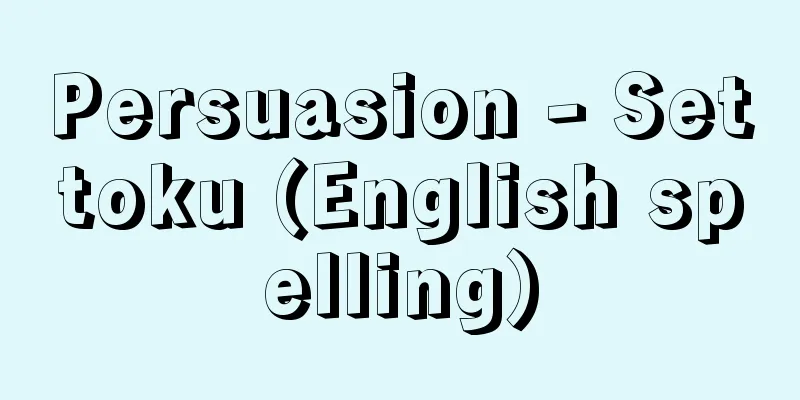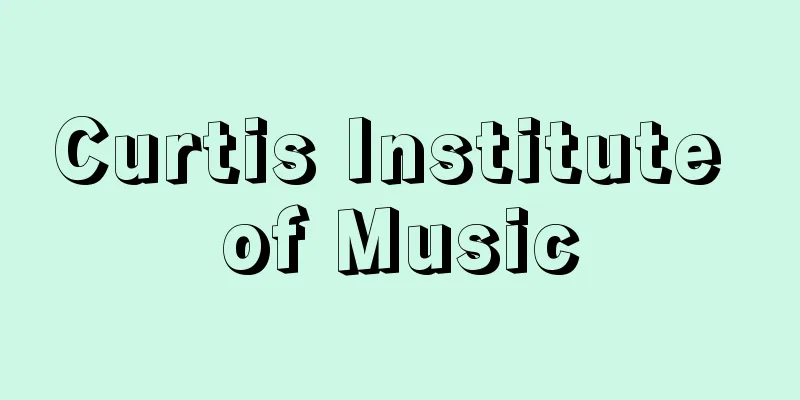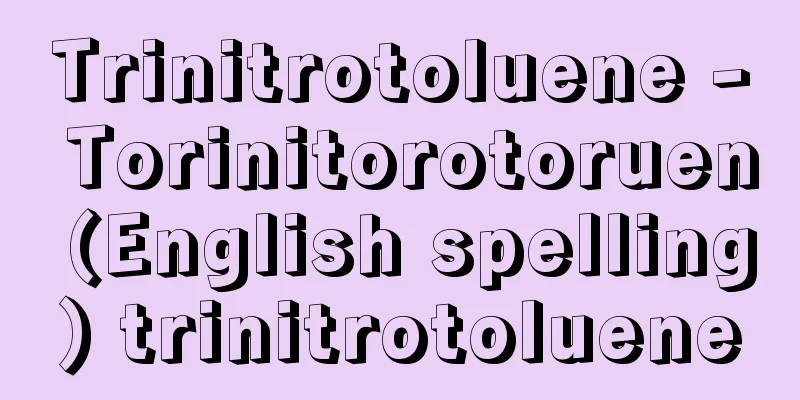Persuasion - Settoku (English spelling)

|
Persuasion is a type of social influence in which the sender (persuader) intentionally and effectively presents a persuasive message, primarily verbal, to the receiver (persuadee) on a problem (persuasion theme) that is expected to be resisted or opposed by the receiver, and attempts to change the receiver's attitude and behavior toward the persuasion theme in the direction desired by the sender, while respecting the receiver's free will. The sender sets a goal for the receiver to take a certain action or have a certain thought. This is because the receiver is behaving in a way that the sender does not want, or is holding an attitude that the sender does not want. Furthermore, simply conveying the sender's request to the receiver is likely to result in resistance, and it is not possible to obtain acceptance or approval. In order to logically assert the validity of their request, the sender presents the receiver with arguments that serve as reasons, and attempts to change the receiver's attitude and behavior (attitude change/behavior change). In this case, the sender does not force the receiver to change his/her attitude or behavior, but rather encourages the receiver to fully understand and be convinced of the meaning and significance of changing his/her attitude and behavior before accepting. [Four determinants of persuasion] There are four factors that determine the recipient's reaction to persuasion (persuasive effect): the attributes of the sender, the structure of the persuasive message, the persuasive situation, and the attributes of the recipient (Hiroki Fukada, 2002). 1. Attributes of the sender The factors that are of interest as attributes of the sender are the sender's credibility and likability. Credibility is considered to be composed of expertise and reliability. Expertise is a wealth of specialized knowledge and skills in a particular field, and often involves holding publicly recognized qualifications. As expertise increases, legitimacy is also maintained by holding qualifications that are publicly backed. The other side of credibility is when the sender does not prioritize only his or her own interests, but rather uses the specialized knowledge he or she possesses for the benefit of the receiver, thereby earning the receiver's trust. In general, recipients of persuasion tend to be influenced by trusted experts, but according to a meta-analysis by Stiff, JB (1986), there is not necessarily a consistent effect between credibility and persuasive effects. The same correlation is observed in the case of favorability. In general, the higher the favorability of the sender (Rhoads, KVL, & Cialdini, RB, 2002), the higher the physical attractiveness (Chaiken, S., 1979), and the higher the similarity between the sender and the receiver (Berscheid, E., 1966), the greater the persuasive effect is expected to be. However, this effect is obtained when the self-relevance of the persuasive topic is low for the receiver. When the persuasive topic is not relevant to the receiver himself or the judgment result is not thought to have much impact on the receiver, the receiver is expected to make a judgment based on the sender's attributes (credibility and favorability) without carefully examining or scrutinizing the content of the persuasive message (see the scrutiny possibility model described below). However, when the self-relevance of the persuasive topic is high, the receiver will try to make a judgment after carefully examining the content of the persuasive message, rather than making a judgment based on the sender's attributes, and the influence of the sender's attributes is expected to be relatively small. In addition, O'Keefe, DJ (1987) pointed out that the persuasive effect differs depending on when the sender's credibility information is presented to the receiver. In the case of a sender with low credibility, presenting the information after the persuasive message has a relatively greater persuasive effect. The phenomenon that the persuasive effect of a persuasive message with information on the sender's credibility differs over time is called the sleeper effect. Over time, the credibility information and the persuasive message become separated, and in the case of a sender with low credibility, the persuasive effect is greater when a certain amount of time (for example, about four weeks) has passed since the presentation of the persuasive message than immediately after it is presented (Hovland, CI, & Weiss, W., 1951). However, a meta-analysis by Allen, M. and Stiff (1989) did not recognize this as a robust phenomenon. 2. Structure of persuasive messages This is the second factor that determines the persuasive effect on the receiver. The contents of the structure of persuasive messages include one-sided and two-sided presentation of arguments, whether or not the conclusion is clearly stated, the order in which arguments are presented, and the arousal of fear. Usually, when a sender creates a persuasive message, he or she prepares arguments to support his or her argument in order to gain the receiver's approval. For example, when encouraging the receiver to quit smoking, the sender presents reasons for recommending smoking cessation. These reasons include the fact that smoking has a negative effect on the body, that secondhand smoke causes inconvenience to people around, and that it is expensive to purchase cigarettes. In this way, one-sided presentation presents only the reasons that support the sender's argument. In this case, the receiver's argument is ignored, which is likely to cause repulsion, or psychological reactance (Brehm, SS, & Brehm, JW, 1981), making it difficult to obtain the receiver's approval. Therefore, it is possible to take the receiver's thoughts into consideration and mention not only the sender's argument but also the receiver's perspective in the persuasive message. This is two-sided presentation. In response to the sender's arguments above, the benefits of smoking include being able to relieve boredom, feeling calm (or being bothered), the appearance of smoking being cool (some people think), and (some people) being able to enjoy the aroma of various types of tobacco. However, for the sender, presenting the receiver's arguments alone would only reinforce the receiver's ideas, so it is necessary to refute those arguments to show that they are in fact incorrect. In other words, the most persuasive effect is achieved when the persuasive message is structured as "sender's argument → receiver's argument (rebuttal) → rebuttal." In this case, clearly presenting the sender's arguments is also an important factor in increasing the persuasive effect (Allen, 1991; O'Keefe, 1999). As mentioned above, the information contained in a persuasive message can be divided into arguments that support the sender and counterarguments against them. In other words, they are advantages and disadvantages. The effectiveness of the order in which the two are presented has also been examined (the order effect in persuasion). The primacy effect seems to be recognized in impression formation in interpersonal cognition (Anderson, NH, & Barrios, AA, 1961; Stewart, RH, 1965). However, when creating a persuasive message that presents both sides of the message, in what order should the opposing information of advantages and disadvantages be presented effectively? Haugtvedt, CP and Wegener, DT (1994) made the following points using the persuasive themes of the introduction of a university graduation certification exam and the construction of a nuclear power plant. When the recipient's ego-involvement in the persuasive theme is low, they do not try to examine the persuasive message very much and are easily influenced by information presented immediately before the judgment, resulting in the recency effect. Conversely, when ego-involvement is high, participants tend to carefully examine the persuasive message from the beginning, and a primacy effect is observed. However, in a study by Imai (2009) using the same persuasive theme of graduation exam introduction, no interaction like that observed in Hoogtvedt and Wegener (1994) was observed. In addition, an experiment in which the information was presented in three stages, rather than in two stages (pros → cons, or cons → pros) as used by Imai and Wegener showed that when ego-involvement is low, a single presentation of the pros is effective, but when ego-involvement is high, it seems more effective to present information about the pros later in the persuasive message. Further investigation is needed into the order effect of persuasion. When the persuasive topic is about encouraging health and safety behavior, it is possible to evoke feelings of fear or threat in the recipient. For example, presenting the recipient with descriptions, photos, or videos of lungs polluted by smoking or the tragic situations following traffic accidents. According to Fukada (2002) and Perloff, RM (2003), in such cases, evoking fear can induce a change in the recipient's attitude compared to not evoking fear. Furthermore, providing information on how to reduce such fear or threat makes it easier for attitude and behavior to change in the direction advocated by the sender. Other effective ways to create persuasive messages, according to Petty, RE and Wegener (1998), include providing a causal explanation that is relevant to the sender's argument, explaining something that fits the receiver's values, mentioning the benefits of acting in the way the sender claims, and mentioning the novelty or uniqueness of the results that will be achieved (if such aspects exist). 3. Persuasive Situation Factors related to the persuasive situation include advance notice of persuasion, repetition of persuasion, number of senders, persuasive obstacles (noise, humid weather, etc.), and the medium of transmission of the persuasive message (e.g. text, still images, video). First, advance notice of persuasion is when the sender gives a notice of persuasion or presents the sender's argument before presenting the persuasive message to the receiver. According to Ueno Tokumi (2002), especially when the ego-involvement in the persuasive topic is high, advance notice of persuasion is likely to generate resistance in the receiver and reduce the persuasive effect. Conversely, when the ego-involvement is low and the sender's likability is high, advance notice of persuasion increases the persuasive effect. Wood, W. and Quinn, JM (2003) conducted a meta-analysis of 37 studies on advance notice of persuasion, dividing the studies into those in which attitudes were measured after advance notice and before the presentation of the persuasive message, and those in which attitudes were measured after advance notice and the presentation of the persuasive message, and compared the attitudes of the control group that did not receive advance notice. The results showed that when attitudes were measured after the presentation of the persuasive message, the warning caused resistance in the recipients. Furthermore, resistance tended to be even greater when it was pointed out that the persuasion in question was relevant to the recipients, or when they were asked to write down their thoughts about the persuasive topic between the warning and the presentation of the persuasive message. Presenting a persuasive message to the receiver repeatedly (multiple presentations compared to one presentation) promotes the receiver's understanding and increases the persuasive effect, but the more times the message is presented (e.g., five presentations compared to three presentations), the more likely the receiver's counterarguments come to mind, and the less effective the message is (Cacioppo, JT, & Petty, 1979). It is thought that the more senders there are, that is, when the sender-to-receiver ratio is many-to-one, the more effective the message is. However, Harkins, SG, and Petty (1981) point out that the more effective the message is when each sender presents different arguments. Conversely, it is thought that the effectiveness of persuasion will decrease if there are environmental factors that hinder persuasion, and Buller, DB (1986) confirmed this prediction in a meta-analysis. Rather than the persuasive effect decreasing when there are hindering factors, it seems that the understanding of the persuasive message is hindered, resulting in a decrease in the effectiveness of the message. In addition, according to a meta-analysis by Stiff and Mongeau, PA (2003), when the sender's persuasive message is well-liked and easy to understand, videos tend to be more effective than text. 4. Attributes of the recipient As personal attributes that are easily influenced by persuasive messages, self-esteem, gender, need for cognition (Casioppo & Petty, 1982), self-monitoring (Snyder, M., 1974), dogmatism (Rokeach, M., 1954), etc. have been pointed out. An inverted U-shaped relationship has been recognized between self-esteem and susceptibility to persuasion, and people with low or high self-esteem are less likely to be persuaded (Rhodes, M., & Wood, 1992). Regarding gender, Eagly, AH and Carli, LL (1981) conducted a meta-analysis and found that women tend to be more easily persuaded than men. However, compared to other factors, the gender of the recipient does not seem to have a relatively robust effect. Moreover, Perloff (2003) focuses on individual differences, rather than on how easily people are persuaded, in terms of what type of persuasive message would be effective for individuals with various personalities. For individuals with a high need for cognition who like to think, it is more effective to present a persuasive message that is composed of persuasive arguments with clear evidence. For individuals with a high tendency for self-monitoring, who closely monitor the situation they find themselves in and try to control their own behavior so that they act in a way that suits the situation, it is better to present what is socially appropriate behavior. For individuals with a high tendency for dogmatism, who are not open to novelty and place importance on traditional and authoritative things, it is effective to present a persuasive message from an authority or expert. [Descriptive model of receiver's processing of persuasive messages] Whether or not a receiver is convinced by a persuasive message from a sender, agrees with the attitude advocated in the persuasive message, and puts it into practice depends largely on the receiver's cognition. Therefore, models describing how receivers process persuasive messages were proposed at roughly the same time by Chaiken, S. (1980), Cacioppo, JT, and Petty (1979). These are called the heuristic systematic model and the elaboration likelihood model (ELM), respectively. Both are based on the idea that there are two processes by which receivers process persuasive messages, and are therefore called dual processing models. The idea that our cognitive processing is a dual process has become a common way in which researchers in recent years have understood phenomena, such as the dual-processing model of interpersonal cognition (Brewer, MB, 1988) and the dual-process theory of reasoning (Evans, J. St. BT, & Over, DE, 1996). The heuristic systematic model and the scrutiny likelihood model model the information processing of the receiver in a similar framework, and there are about three times as many studies on the latter, so we will look at the latter here. In the scrutiny likelihood model, "scrutiny" (elaboration) means carefully considering and examining the content of the persuasive message. In the case of a text, it means reading and understanding it carefully, recalling related information one has, and judging whether or not one agrees with it. The decision to scrutinize the persuasive message is influenced by the sender's state and surrounding circumstances when the persuasive message is received, and the likelihood (likelihood) of scrutiny fluctuates. Petty and Cacioppo (1986) called the process of scrutinizing the persuasive message the central route, and the process of not scrutinizing the message the peripheral route. In the case of the peripheral route, the decision is not based on the content of the persuasive message, but on peripheral clues associated with the persuasive message and the situation at the time (such as the sender's expertise, likability, and number of arguments). The two routes are not mutually exclusive, but rather, persuasive messages are processed in a continuous mixture of the two, ranging from processes involving only the central route to processes involving only the peripheral route. A number of factors influence which process a recipient of a persuasive message will use to process it. If the recipient has a high level of ego-involvement in the persuasive topic, is highly motivated to understand the persuasive message, and has sufficient ability to do so, the message is more likely to be processed via the central route. Conversely, if the recipient has a low level of ego-involvement or there are factors that hinder the understanding of the persuasive message, the message is more likely to be processed via the peripheral route. It has also been pointed out that judgments (attitude change) made via the central route are highly consistent with subsequent behavior, but that in the case of the peripheral route, there is low consistency between attitude change and behavior (even if attitude change occurs). [Resistance to persuasion] Traditional persuasion research has focused on clarifying factors that increase the persuasive effect on the receiver, but in recent years, receiver-focused research has also been conducted on how the receiver can resist such persuasive efforts. In other words, the perspective is to increase the receiver's "interpersonal influence literacy" so that the receiver is not unduly influenced by the sender. Knowls, ES and Linn, JA (2003) list psychological reactance, distrust, scrutiny, and inertia as factors related to receiver resistance to persuasion. If the receiver's judgment or freedom of choice is threatened, psychological reactance is likely to occur and the receiver will be less likely to be influenced by the persuasive message, and even if the receiver has distrust or negative feelings toward the sender or the message content, the receiver will be less likely to be influenced. Furthermore, scrutinizing the sender and the persuasive message from various aspects can also lead to resistance to influence. And, instead of actively resisting, doing nothing (non-response) can also result in resistance to the persuasive message. Brinõl, P. et al. (2003) focused on individual differences in resistance and created the Resistance Persuasion Scale and the Bolster-Counterargue Scale. The former is a scale that measures the recipient's perception of their own susceptibility to persuasion (how easily they are persuaded), and the latter is a scale that measures the methods they use to resist persuasion. For specific questions, see Shakarchi, RI and Hoogtvedt (2003). Tormala, ZL and Petty (2003) created the concept of attitude certainty and pointed out that even if a persuasive message does not cause a change in the recipient's attitude, the certainty of that attitude will change. In other words, it is necessary to confirm not only whether an attitude change has occurred, but also whether the attitude certainty has changed. [Model of behavior change] In many cases, the purpose of persuasion is not just to change the attitude of the recipient, but to get the recipient to take the action that the sender wants. To do this, it will be necessary to consider factors other than attitude change (persuasion). Related to this idea is Ajzen, I.'s Theory of Planned Behavior (1981, revised edition 2006). The behaviors that are the subject of the theory of planned behavior are not habitual or automatic behaviors, but behaviors that we perform intentionally. The direct factor that causes such behavior is our intention. Three factors affect the intention: attitude, subjective norm (expectations from important others), and sense of control. As we have already seen, attitude is the receiver's evaluation of the target behavior, and the more positive it is, the higher the intention to perform the target behavior. Subjective norm is how important others around the receiver (including experts, family, friends, etc.) expect the receiver to behave, and such social pressure forms the receiver's subjective norm. Sense of control is the knowledge and skills to perform the target behavior, and the more abundant these are, the higher the intention, and it is believed that this factor alone has a direct effect on actual behavior. In the revised model, the three factors mentioned above are considered to be influenced by new factors called "behavioral beliefs," "normative beliefs," and "control beliefs." Behavioral beliefs are the subjective probability that performing the target behavior will bring about a given outcome. If the probability of the outcome being desirable for the recipient is judged to be high, a more positive attitude will be formed and intention will increase. Similarly, normative beliefs are cognitions regarding how important others expect one to behave. Various expectations from important others are synthesized to form subjective norms. Control beliefs are cognitions regarding the factors that hinder and promote the execution of the target behavior, and these are synthesized to form a sense of control. Research on the validity of the old version of the theory of planned behavior has been conducted on health-related behavior, environmentally conscious behavior, and leisure behavior choices, and according to a meta-analysis by Armitage, CJ and Conner, M. (2001), this model can explain 39% of "intentions" and 27% of "behavior," and it can be judged to have a certain degree of validity. In addition, models that are specific to health-related behavior include the health belief model (Maiman, LA, & Becker, MH, 1974) and protection motivation theory (Rogers, RW, 1983), and the validity of these models is being examined. → Compliance [Yoshiaki Imai] Latest Sources Psychology Encyclopedia Latest Psychology Encyclopedia About Information |
|
説得とは,受け手persuadeeの抵抗や反対が予測される問題(説得テーマ)について,送り手persuaderが主として言語的な説得メッセージを受け手に対して意図的・効果的に呈示し,受け手の自由意志を尊重しながら,説得テーマに対する受け手の態度と行動を送り手の望む方向に変えようとする社会的影響の一種である。送り手は,受け手に対してある行動を取ってほしい,あるいはある考えをもってほしいという目標を設定する。受け手が送り手の望まない行動を行なっていたり,望まない態度を保持していたりするからである。しかも,送り手の要求を単に受け手に伝えるだけでは抵抗が予測され,応諾や賛同を得ることができない。送り手は,自分の要求の妥当性を論理的に主張するために,理由となる論拠を受け手に呈示して,受け手の態度や行動を変容(態度変容・行動変容)させようとする。その際,送り手は,受け手の態度や行動を強制的に変容させるのではなく,受け手が態度や行動を変容させることの意味や意義を十分理解し,納得したうえで応諾するように働きかける。 【説得の4種の規定要因】 説得の受け手の反応(説得効果)を規定する要因として四つが挙げられる。すなわち,送り手の属性,説得メッセージの構成,説得の状況,そして受け手の属性である(深田博己,2002)。 1.送り手の属性 送り手の属性として注目される要因は,送り手の信憑性credibilityと好感度likabilityである。信憑性は,専門性と信頼性から構成されるととらえられている。専門性とはある特定の領域における専門的知識や技能が豊富なことであり,公的に認められた資格を保有していることが多い。専門性が大きくなると,公的な裏づけのある資格を保持することによって正当性も保持するようになる。もう一方の信頼性とは,送り手が自己利益のみを優先させるのではなく,受け手の利益のために自分のもっている専門的知識を活用することによって受け手から信頼されることである。一般に,説得の受け手は,信頼できる専門家からの影響を受ける傾向があるが,スティフStiff,J.B.(1986)のメタ分析によれば,信憑性と説得効果との間に必ずしも一貫的な効果は認められていない。 そうした関連性は,好感度の場合も同じである。一般に,送り手の好感度が高く(Rhoads,K.V.L., & Cialdini,R.B.,2002),身体的魅力度が高く(Chaiken,S.,1979),送り手と受け手の類似性が高い(Berscheid,E.,1966)ほど,説得効果は大きいと考えられるが,その効果が得られるのは,説得テーマの自己関連度が受け手にとって低い場合である。説得テーマが受け手自身に関連していない,または判断結果が受け手にあまり大きな影響を与えないと考えられる場合,受け手は説得メッセージの内容についてよく吟味や精査をせずに,送り手の属性(信憑性や好感度)に基づいて判断すると考えられる(後述の精査可能性モデルを参照)。しかし,説得テーマの自己関連度が高い場合は,送り手の属性に基づいて判断を下すというよりも,説得メッセージの内容をよく吟味したうえで判断を下そうとするので,相対的に送り手の属性による影響は小さくなると考えられる。また,オキーフO'Keefe,D.J.(1987)は,送り手の信憑性情報をどの時点で受け手に呈示するかによっても説得効果が異なることを指摘している。信憑性が低い送り手の場合は,説得メッセージの後に呈示した方が,相対的に説得効果が大きいということである。 送り手の信憑性情報付きの説得メッセージの説得効果が時間経過とともに異なることを示す現象がスリーパー効果sleeper effectである。時間経過とともに,信憑性情報と説得メッセージが分離され,信憑性が低い送り手の場合は,説得メッセージ呈示後,ある程度の時間(たとえば,4週間ほど)経過した方が,呈示直後よりも説得効果が大きくなるという現象である(Hovland,C.I.,& Weiss,W.,1951)。しかし,アレンAllen,M.とスティフ(1989)のメタ分析では,頑健な現象としては認められていない。 2.説得メッセージの構成 受け手の説得効果を規定する第2の要因である。説得メッセージの構成の内容は,論拠の一面呈示と両面呈示,結論の明示の有無,論拠の呈示順序,恐怖喚起などがある。通常,送り手の説得メッセージを作成する際には,受け手の賛同を得るために,自分の主張を裏づける論拠を用意する。たとえば,受け手に禁煙を促す場合には,禁煙を勧める理由を呈示する。喫煙が身体に悪影響を及ぼすこと,副流煙が周囲の人に迷惑をかけること,タバコを購入するコストがかかることなどである。このように送り手の主張を裏づける理由のみを呈示するのが一面呈示である。この場合には,受け手の言い分を無視するような形になり,受け手の反発すなわち心理的リアクタンス(Brehm,S.S.,& Brehm,J.W.,1981)を引き起こしやすく,受け手の賛同を得にくくなる。そこで,受け手の考えも考慮して説得メッセージの中に送り手の主張点だけではなく,受け手の視点にも言及することが考えられる。それが両面呈示である。上記の送り手の主張点に対して,喫煙のメリットとして,手持ちぶさたを解消できること,気持ちが落ち着く(気になる)こと,喫煙する姿が格好いい(と思う人がいる)こと,(人によっては)いろいろなタバコの香りを楽しむことができることなどである。しかし,送り手にとって,受け手側の論拠を呈示したままでは,受け手の考えを補強することになるため,それらの論拠が実際には誤りであることを示すように,反駁する必要がある。つまり,説得メッセージの構成を「送り手の主張→受け手の主張(反論)→反駁」というようにすると,最も説得効果が大きい。その際に,送り手の主張点を明確に呈示することも説得効果を高める重要な要因である(Allen,1991; O'Keefe,1999)。 説得メッセージに含まれる情報は,上記のように,送り手側を支持する主張点とそれに対する反論とに分けることができる。言い換えれば,長所と短所である。両者の呈示順序の効果性についても検討されている(説得の順序効果)。対人認知における印象形成においては,初頭効果が認められているようであるが(Anderson,N.H.,& Barrios,A.A.,1961;Stewart,R.H.,1965),説得において両面呈示の説得メッセージを作成する場合,長所と短所という相反する情報をどのような順序で呈示することが効果的なのであろうか。ホーグトベットHaugtvedt,C.P.とウェゲナーWegener,D.T.(1994)は,大学の卒業認定試験導入,原子力発電所の建設という説得テーマを用いて,次のような指摘をしている。説得テーマに対する受け手の自我関与度が低い場合は,あまり説得メッセージを吟味しようとせず,時間的に判断の直前に呈示された情報の影響を受けやすくなるので新近効果recency effectが生じる。逆に,自我関与度が高い場合は,説得メッセージを初めからよく精査しようとするので,相対的に初頭効果primacy effectが認められる。しかし,卒業試験導入という同じ説得テーマを用いた今井(2009)の研究においては,ホーグトベットとウェゲナー(1994)のような交互作用は認められなかった。また,彼らが用いたように情報呈示を2段階(長所→短所,または,短所→長所)で呈示するのではなく,3段階にした場合の実験から,自我関与度が低いときは,長所のみの一面呈示で説得効果があるが,自我関与度が高い場合は長所の情報を説得メッセージの後の方に呈示することが効果的でありそうだということである。説得の順序効果については,さらに検討が必要であると言える。 説得テーマが健康や安全行動を促す内容の場合には,受け手に恐怖感情や脅威を喚起することが可能である。たとえば,喫煙によって汚れた肺,交通事故後の悲惨な状況などに関する記述や写真,動画を受け手に呈示することである。深田(2002)やパーロフPerloff,R.M.(2003)によれば,こうした場合,恐怖を喚起することは,恐怖を喚起しない場合に比べて,受け手の態度変容を引き起こすことができる。さらに,そうした恐怖や脅威を低減するにはどのようにすればよいかという情報を提供すると,送り手の主張する方向への態度変容,行動変容が生じやすくなる。 そのほか,説得メッセージの効果的な作成方法についてペティPetty,R.E.とウェゲナー(1998)は,送り手の主張点に関連して因果的に説明すること,受け手の価値観に適合するように説明すること,送り手の主張どおりに行動することのメリットに言及すること,もたらされる結果の新奇性や独自性(そうした側面があれば)に言及することなどを挙げている。 3.説得の状況 説得の状況に関する要因として,説得の予告,説得の反復,送り手の人数,説得の妨害要因(騒音,蒸し暑さなど),説得メッセージの伝達メディア(たとえば,テキスト文,静止画,動画)などを挙げることができる。まず,説得の予告とは,受け手に説得メッセージを呈示する前に,説得することを予告したり,送り手の主張点を呈示しておいたりすることである。上野徳美(2002)によれば,とくに説得テーマへの自我関与度が高い場合,説得することの予告は,受け手の抵抗を生みやすく,説得効果が低下する。逆に,自我関与度が低い場合,送り手の好感度が高ければ,説得の予告が説得効果を高めるという。ウッドWood,W.とクウィンQuinn,J.M.(2003)は,説得の予告に関する37研究のメタ分析を行ない,①予告後,説得メッセージ呈示前に態度測定をした場合と,②予告と説得メッセージの呈示後に態度測定した場合とに区分し,予告を受けなかった統制群の態度と比較した。その結果,説得メッセージ呈示後に態度測定される場合は,予告によって受け手の抵抗が生じていた。さらに,当該の説得が受け手に関連していると指摘された場合,あるいは,予告と説得メッセージ呈示との間に,説得テーマについて考えたことを記述させられた場合は,その抵抗はさらに大きい傾向にあった。 説得メッセージを繰り返して受け手に呈示することは(1回呈示に比べ,複数回呈示の場合は),受け手の理解を促し,説得効果を高めるけれども,反復して呈示する回数が多くなると(たとえば3回呈示に比べて5回呈示の場合は),受け手の反論が頭に浮かびやすくなり,説得効果は低減するようである(Cacioppo,J.T.,& Petty,1979)。送り手の人数が多くなるほど,つまり,送り手対受け手が多対1になると,説得効果は高まると考えられるが,ハーキンスHarkins,S.G.とペティ(1981)によれば,各送り手が異なる論拠を呈示することが説得効果を高めると指摘している。逆に,説得を妨害するような環境要因が存在すると,説得効果は低下すると考えられるが,そうした予測をブラーBuller,D.B.(1986)は,メタ分析で確認している。妨害要因が存在していると,説得効果が低下するというよりは,説得メッセージの理解が妨害され,結果として説得効果が低下するようである。また,スティフとモンギュMongeau,P.A.(2003)のメタ分析によれば,送り手の好感度が高く,理解しやすい説得メッセージの場合は,テキスト文よりは動画を用いた方が説得効果の高い傾向にある。 4.受け手の属性 説得メッセージからの影響を受けやすい個人的属性として,自尊心,性別,認知欲求(Casioppo & Petty,1982),セルフ・モニタリング(Snyder,M.,1974),独断主義(Rokeach,M.,1954)などが指摘されている。自尊心と説得されやすさ(被説得性)との間には,逆U字型の関係が認められており,自尊心が低くても高くても説得されにくい(Rhodes,M.,& Wood,1992)。性別については,イーグリEagly,A.H.とカーリCarli,L.L.(1981)がメタ分析を行ない,女性の方が男性よりも説得されやすい傾向にあることを見いだしている。しかし,他の要因に比べれば,受け手の性別は相対的に頑健な効果をもたないようである。 また,パーロフ(2003)は,説得のされやすさというよりも,各種のパーソナリティをもった個人に対してどのような説得メッセージを作成することが効果的かという観点から個人差に注目している。考えることが好きな認知欲求度の高い個人に対しては,説得力ある,根拠の明確な論拠から構成される説得メッセージを呈示した方が効果的である。自分のおかれた状況をよくモニターして,その状況に合った行動を取るように自分の行動をコントロールしようとするセルフ・モニタリング傾向の高い個人に対しては,社会的に見て適切な行動とは何かを呈示するようにする。また,新奇なものに対して開放的ではなく,伝統的で権威あるものを重視するドグマティズムの高い個人に対しては,権威者や専門家からの説得メッセージであると呈示することが効果的である。 【受け手の説得メッセージ処理の記述モデル】 受け手が送り手からの説得メッセージに納得して,説得メッセージで唱導されている態度に賛同し,実行するようになるかどうかは,受け手の認知に大きく依存している。そこで,受け手が説得メッセージをどのように処理しているかを記述するモデルが,ほぼ時を同じくしてチェイキンChaiken,S.(1980),カシオッポCacioppo,J.T.とペティ(1979)によって提唱された。それぞれヒューリスティック・システマティック・モデル,精査可能性モデル(精緻化見込みモデル)elaboration likelihood model(ELM)とよばれている。両者とも,受け手による説得メッセージを処理するプロセスには二つあるという考え方なので,二重過程モデルdual processing modelとよばれている。われわれの認知的処理が二重過程になっているというとらえ方は,近年の研究者が現象をとらえる一つの共通項になっており,たとえば,対人認知の二重処理モデル(Brewer,M.B.,1988)や推論における二重過程理論(Evans,J.St.B.T.,& Over,D.E.,1996)がある。 ヒューリスティック・システマティック・モデルと精査可能性モデルは,ほぼ同じような枠組みで受け手の情報処理をモデル化しており,後者に関する研究の方が約3倍多いので,ここでは後者について見ていくことにする。精査可能性モデルの「精査」(精緻化)とは,説得メッセージの内容をよく検討し,吟味することである。テキスト文であれば,それをよく読んで理解し,自分がもっている関連情報も思い出しながら,賛同するかどうかを判断することである。精査するかどうかは,説得メッセージを受け取ったときの送り手の状態や周囲の状況の影響を受け,精査する可能性(見込み)が変動する。説得メッセージを精査するプロセスをペティとカシオッポ(1986)は中心ルートとよび,精査されないプロセスを周辺ルートとよんだ。周辺ルートの場合は,説得メッセージの内容に基づいた判断を下すのではなく,説得メッセージやそのときの状況に付随する周辺的手がかり(送り手の専門性,好感度,論拠の数など)に基づいて判断することになる。両ルートは背反的ではなく,中心ルートのみのプロセスから周辺ルートのみのプロセスまで両者が連続的に混合された形で,説得メッセージが処理されるととらえられている。 説得メッセージを受け取った受け手が相対的にどちらのプロセスで処理することになるかは,いくつかの要因の影響を受ける。受け手にとって説得テーマの自我関与度が高く,説得メッセージを理解しようとする動機が高く,また,理解する能力が十分にある場合は,中心ルートで処理される可能性が高くなる。逆に,自我関与度が低かったり,説得メッセージの理解を妨害するような要因が存在したりしていれば,周辺ルートで処理される可能性が高くなる。そして,中心ルートを経て下された判断(態度変容)はその後の行動との一貫性が高いが,周辺ルートの場合は,(仮に態度変容が生じたとしても)態度変容と行動との一貫性は低いと指摘されている。 【説得への抵抗】 従来の説得研究は,受け手に対する説得効果を高めるための要因を明らかにすることに関心が大きく向けられていたが,近年は,そうした説得の働きかけに対して,受け手がいかに対抗できるかという,受け手を重視した研究も行なわれるようになってきた。つまり,受け手が送り手から不当な影響を受けないように,受け手の「対人的影響リテラシー」を高めるという視点である。受け手の説得への抵抗に関連する要因として,ノウルズKnowls,E.S.とリンLinn,J.A.(2003)は,心理的リアクタンス,不信,精査scrutiny,無反応inertiaを挙げている。受け手の判断や選択肢選択の自由が脅やかされれば心理的リアクタンスが生じやすくなって説得メッセージから影響を受けにくくなるし,送り手やメッセージ内容に不信感やネガティブな感情を抱いても,影響を受けにくくなる。さらに,送り手や説得メッセージをいろいろな側面から精査することも影響の抵抗につながる。そして,積極的に抵抗するのではなく,何もしないこと(無反応)も,結果として説得メッセージに抵抗することになる。 ブリニョールBrinõl,P.ら(2003)は,抵抗における個人差に焦点を当て,説得抵抗尺度resistance persuasion scaleと自己鼓舞-反論尺度bolster-counterargue scaleを作成した。前者は,受け手自身の被説得性に関する認知(自分はどの程度説得されやすいのか)を測定する尺度であり,後者は,説得に抵抗するためにどのような方法を用いるかを測定する尺度である。なお具体的な質問項目については,シャカーチShakarchi,R.I.とホーグトベット(2003)を参照。また,トーマラTormala,Z.L.とペティ(2003)は,態度確信度attitude certaintyという概念を作り,説得メッセージによって受け手の態度変容が生じないまでも,その態度の確信度が変容することを指摘している。つまり,単に態度変容が生じたかどうかだけでなく,態度確信度の変容まで確認する必要があるということである。 【行動変容のモデル】 説得の目的は,多くの場合,受け手の態度を変容させるだけでなく,送り手の望む行動を受け手に実行させることである。そのためには,態度変容(説得)以外の要因についても考慮する必要があるだろう。 そうした考えに関連するものとして,エイゼンAjzen,I.の『計画的行動理論Theory of Planned Behavior』(1981,改訂版2006)がある。計画的行動理論で対象とされている行動は,習慣化された行動や自動的に行なわれる行動ではなく,われわれが意図的に行なう行動である。その行動を引き起こす直接的な要因は,われわれの意図である。その意図に影響を与えているのが,態度,主観的規範(重要他者からの期待),コントロール感という3要因である。態度は,すでに見てきたように,対象行動に対する受け手の評価であり,それがポジティブであるほど対象行動を行なおうとする意図は高くなる。主観的規範は,受け手の周囲にいる重要他者(専門家も含め,家族や友人など)が受け手に対してどのように行動するよう期待しているかであり,そうした社会的圧力が受け手の主観的な規範を形成する。コントロール感は,対象行動を行なうことの知識やスキルであり,それらが豊富であるほど,意図は高くなると同時に,この要因だけは,実際の行動にも直接的な影響を与えていると考えられている。改訂版のモデルでは,上記三つの要因に対して,それぞれ「行動的信念」,「規範的信念」,「コントロール的信念」という新しい要因が影響を与えているととらえられている。行動的信念とは,対象行動を行なうことが所与の結果をもたらすという主観的確率である。受け手にとって望ましい結果をもたらす確率が高いと判断されれば,それだけポジティブな態度が形成されることになり,意図が高まる。同様に規範的信念は,重要他者が自分にどのような行動を期待しているかに関する認知である。いろいろな重要他者からの期待が合成されて主観的規範となる。コントロール的信念は,対象行動を実行する際の妨害要因や促進要因に関する認知であり,それらが合成されてコントロール感が形成される。旧版の計画的行動理論の妥当性に関する研究は,健康関連行動や環境配慮行動,レジャー行動の選択などを対象にして行なわれ,アーミティジArmitage,C.J.とコナーConner,M.(2001)のメタ分析によれば,「意図」の39%,「行動」の27%をこのモデルで説明可能であり,ある程度の妥当性があると判断できる。 なお,健康関連行動に特化させたモデルとしては,健康信念モデル(Maiman,L.A.,& Becker,M.H.,1974)や防護動機理論(Rogers,R.W.,1983)もあり,モデルの妥当性が検討されている。 →応諾 〔今井 芳昭〕 出典 最新 心理学事典最新 心理学事典について 情報 |
Recommend
K-Mart [company] - K-Mart
A major retail company that operates mainly discou...
Tenmazuka - Heavenly Horse Tomb
A wooden coffin tomb from Silla during the Three ...
Otavalo people
...The inhabitants called mestizo usually include...
Craton (English spelling)
An area that is no longer subject to mountain-buil...
Stapelia variegata (English spelling) Stapelia variegata
… [Hiroshi Yuasa]. … *Some of the terminology tha...
Ceriman
...This genus has more than 25 species in tropica...
Cavalieri's theorem
When there are two figures, A and B , on a plane, ...
Park Güell
He combined the rational development of Gothic ar...
"Modern View of Love" - Kindai no Renaikan
…This could be said to be another characteristic ...
Wang Bo - Oubo
A Chinese poet of the early Tang dynasty. He was ...
Emery Raising Machine - Emery Kimouki
…Wire nap machines, which pass the cloth over a r...
Kankata
A general term for instrumentalists in gagaku, esp...
Akakohon - Akakohon
〘Noun〙 The name for the early akahon books produce...
Buddlejaceae
...In China, the flowers and stems are used for m...
Shiwa [town] - wrinkle
A town in Shiwa County in central Iwate Prefecture...









